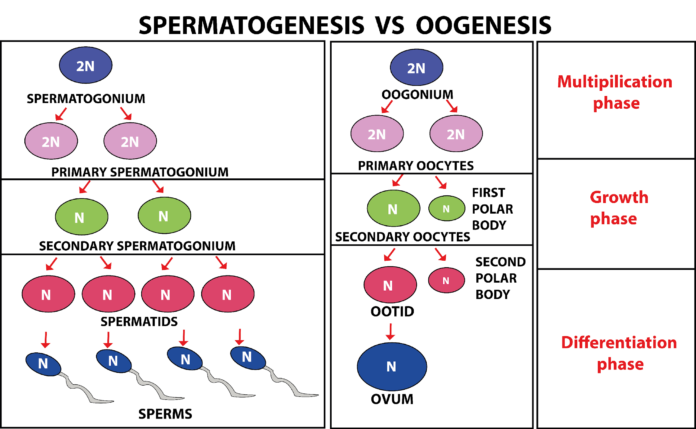During gametogenesis, sperm and eggs are generated by meiosis. Two cell divisions separate the paired chromosomes in the nucleus during meiosis. The chromatids are created early in the cell’s life cycle, resulting in gametes with half as many chromosomes as the parent. The process of creating sperm is known as spermatogenesis, whereas the process of producing eggs is known as oogenesis.
Introduction
Animals that reproduce sexually undergo two types of reproductive divisions: spermatogenesis and oogenesis. Meiosis, or reproductive division or gametogenesis, occurs in the gonads’ germ cells. It contributes to the creation of gametes. Haploid gametes are produced by diploid germ cells. Male and female gametes are the two different kinds of gametes that are present. Gametes of both sexes are known as sperms and eggs, respectively. To create the diploid zygote, which divides and develops into a new organism, one sperm is combined with an egg.
The process by which sperm are produced from male germ cells and spermatogonia in males is known as spermatogenesis. In contrast, oogenesis is the process of producing eggs from female germ cells and oogonia in females.
Spermatogenesis
is the process through which spermatogonia in the testis produces male gametes or sperm. The cells that make up the spermatogonium are diploid. The testis, a man’s main reproductive organ, contains it in its microscopic tubules. Each spermatogonium produces four haploid spermatozoa. Meiosis, a cell division process, is used. Male puberty is when spermatogenesis begins. During the duration of a male’s life, millions of sperms are created each day.
Oogenesis
is the process through which oogonia in the ovary produces female gametes or ova. The primary oocyte is a diploid cell that divides into two ovules through meiosis. Each of the two meiotic stages produces one of the two created polar bodies. Between adolescence and menopause, oogenesis happens once each month.
Difference between spermatogenesis and oogenesis
Properties |
Spermatogenesis |
Oogenesis |
| Definition | The procedure for producing sperm from spermatogonia is known as spermatogenesis. | The procedure for producing eggs from oogonia is called oogenesis. |
| Location | Males’ testicles are where spermatogenesis takes place. | In females, the ovary is where oogenesis takes place. |
| Stages | Inside the testis, the entire spermatogenesis process takes place. | All phases of oogenesis—aside from the final one—take place inside the ovary. Inside the oviduct, the final phase takes place. |
| Releasing | From the testis, sperm are expelled. | The ovary, which matures later, releases oocytes. |
| Continuity | Spermatogenesis is an ongoing process that starts after puberty and lasts till death. | The fetal stage is when the early phases of oogenesis occur. After puberty, the remaining steps take place. Up until menopause, only one ovum is generated each month. |
| Spermatogonia/Oogonia | The seminiferous tubules’ germinal epithelial lining is where spermatogonia form. | The germinal epithelium, which covers the ovary, develops into oogonia. |
| Sertoli Cells | The germinal cell epithelium contains Sertoli cells that support the germinal cells. | The germinal cell epithelium lacks Sertoli cells. |
| Cell Division | Meiosis is the process of spermatogonia dividing, always producing sperm. | During the formation of eggs, certain oogonia divide, one at a time. |
| Growth Phase | Spermatogonia’s growth phase is incredibly short. | In oogonia, the growth period is prolonged. |
| Primary Gametocyte | Meiosis 1 splits the primary spermatocyte into two secondary spermatocytes. | Meiosis 1 divides the primary oocyte, creating a secondary oocyte and one polar body. |
| Secondary Gametocyte | Meiosis 2 splits the secondary spermatocyte into two spermatids. | Meiosis 2 splits the secondary oocyte into an ovum and a single polar body. |
| Cytokinesis | During spermatogenesis, equal cytokinesis takes place, ultimately creating four sperm. | A single ovum, and three polar bodies are produced due to unequal cytokinesis during this process. |
| Result | Four spermatozoa are produced by one spermatocyte. | One oocyte can only result in one ovum. |
| Size | Spermatocytes are larger than sperm. | The oocyte is smaller than the ovum. |
| Nucleus | In the sperm, the nucleus experiences condensation. | The ovum has no nuclear condensation present. |
| Food Reservation | There is hardly much nourishment stored in the sperm. | The ovum holds a large amount of food and biochemical reserves. |
| Motility | Motile gametes are produced during spermatogenesis. | Non-motile gametes are produced during oogenesis. |
Frequently asked question
Q1. What role do Sertoli cells play in sperm development?
Ans. Developing sperm are nourished by Sertoli cells. Following spermatogenesis, the heads of the sperm adhere to Sertoli cells to gather resources for future growth. By using FSH and testosterone, the Sertoli cells help to control spermatogenesis.
Q2. What do “haploid” and “diploid” mean?
Ans. Haploid cells are defined as having only one set of chromosomes. They number 23 in total. Diploid cells are defined as having a full complement of chromosomes. They number 46 in total.
Q3. How do spermatogenesis and oogenesis differ fundamentally?
Ans. One mature ovum is generated during oogenesis, whereas four mature sperm are produced during spermatogenesis.
Q4. What are the names of the several oogenesis stages?
Ans. Oogenesis is divided into three stages: The multiplication stage, the growth stage, and the maturity stage.
Q5. Oogenesis: is it haploid or diploid?
Ans. Meiosis I in oogenesis produces the cell known as the secondary oocyte. It only has one of each homologous pair of chromosomes. It is haploid, in other terms.
